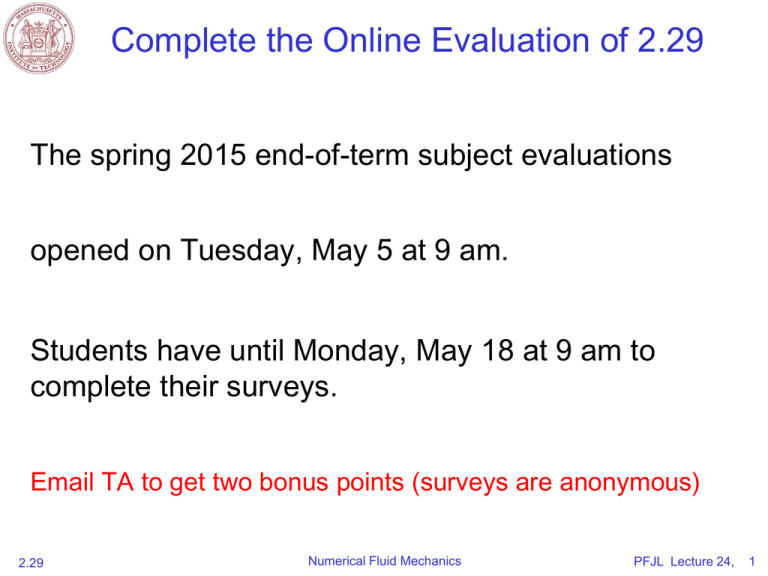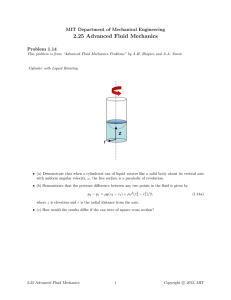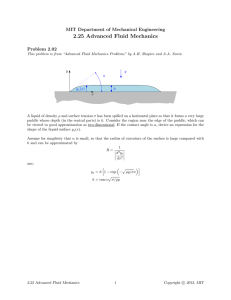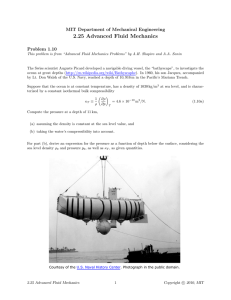
Complete the Online Evaluation of 2.29
The spring 2015 end-of-term subject evaluations
opened on Tuesday, May 5 at 9 am.
Students have until Monday, May 18 at 9 am to
complete their surveys.
Email TA to get two bonus points (surveys are anonymous)
2.29
Numerical Fluid Mechanics
PFJL Lecture 24,
1
2.29 Numerical Fluid Mechanics
Spring 2015 – Lecture 24
REVIEW Lecture 23:
• Finite Element Methods
n
u( x ) ai i ( x ) L u( x ) f ( x ) R( x ) 0
i 1
– Introduction
– Method of Weighted Residuals: Galerkin, Subdomain and Collocation
x dt
– General Approach to Finite Elements:
R(x) wi (x) d
• Steps in setting-up and solving the discrete FE system
0,
i 1,2,..., n
t V
• Galerkin Examples in 1D and 2D
– Computational Galerkin Methods for PDE: general case
• Variations of MWR: summary
• Finite Elements and their basis functions on local coordinates (1D and 2D)
• Isoparametric finite elements and basis functions on local coordinates (1D, 2D,
triangular)
– High-Order: Motivation
– Continuous and Discontinuous Galerkin FE methods:
• CG vs. DG
• Hybridizable Discontinuous Galerkin (HDG): Main idea and example
– DG: Worked simple example
2.29
Numerical Fluid Mechanics
PFJL Lecture 24,
2
TODAY (Lecture 24):
Finite Volume on Complex Geometries
Turbulent Flows and their Numerical Modeling
• Finite Volume on Complex geometries
– Computation of convective fluxes
– Computation of diffusive fluxes
– Comments on 3D
• Turbulent Flows and their Numerical Modeling
– Properties of Turbulent Flows
• Stirring and Mixing
• Energy Cascade and Scales
–
–
–
–
–
2.29
Turbulent Wavenumber Spectrum and Scales
Numerical Methods for Turbulent Flows: Classification
Direct Numerical Simulations (DNS) for Turbulent Flows
Reynolds-averaged Navier-Stokes (RANS)
Large-Eddy Simulations (LES)
Numerical Fluid Mechanics
PFJL Lecture 24,
3
References and Reading Assignments
• Chapter 8 on “Complex Geometries” of “J. H. Ferziger and M. Peric,
Computational Methods for Fluid Dynamics. Springer, NY, 3rd
edition, 2002”
• Chapter 9 on “Turbulent Flows” of “J. H. Ferziger and M. Peric,
Computational Methods for Fluid Dynamics. Springer, NY, 3rd ed.,
2002”
• Chapter 3 on “Turbulence and its Modelling” of H. Versteeg, W.
Malalasekra, An Introduction to Computational Fluid Dynamics: The
Finite Volume Method. Prentice Hall, Second Edition.
• Chapter 4 of “I. M. Cohen and P. K. Kundu. Fluid Mechanics.
Academic Press, Fourth Edition, 2008”
• Chapter 3 on “Turbulence Models” of T. Cebeci, J. P. Shao, F.
Kafyeke and E. Laurendeau, Computational Fluid Dynamics for
Engineers. Springer, 2005
2.29
Numerical Fluid Mechanics
PFJL Lecture 24,
4
Finite Volumes on Complex geometries
• FD method (classic):
– Use structured-grid transformation (either algebraic-transfinite, general,
differential or conformal mapping)
– Solve transformed equations on simple orthogonal computational domain
• FV method:
– Starts from conservation eqns. in integral form on CV
d
dV
CV
dt
CS
(v .n )dA
Advective (convective) fluxes
q .n dA
CS
Other transports (diffusion, etc)
CV
s dV
Sum of sources and
sinks terms (reactions, etc)
– We have seen principles of FV discretization
• Convective/diffusive fluxes, from 1st - 2nd order to higher order discretizations
• These principles are independent of grid specifics, but,
• Several new features arise with non-orthogonal or arbitrary unstructured grids
2.29
Numerical Fluid Mechanics
PFJL Lecture 24,
5
Expressing fluxes at the surface based on cell-averaged (nodal)
values: Summary of Two Approaches and Boundary Conditions
•
Set-up of surface/volume integrals: 2 approaches (do things in opposite order)
1. (i) Evaluate integrals using classic rules (symbolic evaluation); (ii) Then, to obtain
the unknown symbolic values, interpolate based on cell-averaged (nodal) values
(
i ) Fe
Se
(ii ) e
(e )
Fe (P ' s)
Similar for other integrals:
1
(P ' s)
( S s
dV ,
dV , etc)
f dA
Fe
(P ' s)
V
V
V
2. (i) Select shape of solution within CV (piecewise approximation); (ii) impose
volume constraints to express coefficients in terms of nodal values; and (iii) then
integrate. (this approach was used in the examples).
(i ) ai ( x )
( x)
(
x
)
(
x
)
a
i
P
(ii ) ai ( x ) P
Fe (P ' s )
VP
(iii ) Fe f dA
Se
P
•
ai
Similar for higher dimensions:
( x, y )
ai
( x, y ); etc
a ( xP , yP ) P ; etc
i
Boundary conditions:
– Directly imposed for convective fluxes
–
2.29
(From lecture 16)
One-sided differences for diffusive fluxes
Numerical Fluid Mechanics
PFJL Lecture 24,
6
Approx. of Surface/Volume Integrals:
Classic symbolic formulas
• Surface Integrals
(summary from Lecture 15)
yj+1
NW
yj
WW
yj-1
Fe f dA
j
sw
s se
i
x
xi-1
EE
E
∆y
SE
S
xi
xi+1
Notation used for a Cartesian 2D and 3D grid.
Image by MIT OpenCourseWare.
• Midpoint rule (2nd order):
Fe f dA f e Se f e Se O( y ) f e Se
• Trapezoid rule (2nd order):
Fe f dA Se
• Simpson’s rule (4th order):
Fe
2
Se
n ne
P e ne
∆x
– 2D problems (1D surface integrals)
Se
nw
w
SW
y
Se
Se
W
NE
N
( f ne f se )
O( y 2 )
2
( f 4 f e f se )
f dA Se ne
O( y 4 )
6
– 3D problems (2D surface integrals)
• Midpoint rule (2nd order):
Fe f dA Se f e
Se
O( y 2 , z 2 )
• Higher order more complicated to implement in 3D
• Volume Integrals:
S s dV ,
V
1
dV
V V
– 2D/3D problems, Midpoint rule (2nd order):
– 2D, bi-quadratic
2.29
(4th
order, Cartesian):
SP
SP s dV sP V sP V
V
x y
16sP 4ss 4sn 4sw 4se sse ssw sne snw
36
Numerical Fluid Mechanics
PFJL Lecture 24,
7
FV: Approximation of con
convective fluxes
CS
(v .n )dS
Advective (convective) fluxes
• For complex geometries, one often uses the midpoint rule for
the approximation of surface and volume integrals
• Consider first the mass flux: =1:
f 1 v .n
– Again, we consider one face only: east side of a 2D CV (same approach
applies to other faces and to any CV shapes).
– Mid-point rule for mass flux:
N
NW
y
n
n
nw
e
n
W
j
S
i
E
n
se
S
sw
ξ
iξ
n
P
w
iη
SE
n
Se
f 1 dS f e Se f e Se O( 2 ) ( v .n )e Se
– The unit normal vector to face “e” and its surface Se
are defined as: ne Se Sex i Sey j ( yne yse ) i ( xne xse ) j
η
ne
me
x
where
Se
( Sex ) 2 ( Sey ) 2
– Hence, mass flux is:
me ( v.n )e S
e ve .( Sex i Sey
j) e ( Sex ue Sey ve )
e
Image by MIT OpenCourseWare.
2.29
Numerical Fluid Mechanics
PFJL Lecture 24,
8
FV: Approximation of convective fluxes, Cont’d
Mass Flux
me
• The mass flux for the mid-point rule:
e ( Sex ue Sey ve )
• What’s the difference between the Cartesian and nonorthogonal grid cases?
– In non-orthogonal case, normal to surface has components in
all directions
– All velocity components thus contribute to the flux (each
component is multiplied by the projection of Se onto the
corresponding axis)
NW
y
N
n
n
nw
e
n
W
w
η
iη
ξ
iξ
E
n
P
n
se
S
sw
j
ne
n
SE
S
i
x
Image by MIT OpenCourseWare.
2.29
Numerical Fluid Mechanics
PFJL Lecture 24,
9
FV: Approximation of convective fluxes, Cont’d
me
• Mass flux for mid-point rule:
e ( Sex ue Sey ve )
• Convective flux for any transported
– Is usually computed after the mass flux. Using the mid-point
mid
rule:
Fe (v .n ) dS
f e Se ( v .n
)e Se eme
Se
where e = value at center of cell face
– How to obtain e?, use either:
• A linear interpolation between two nodes on either side of face (also 2nd
order) becomes trapezoidal rule
• Fit to a polynomial in the vicinity of the face (piecewise shape function)
– Considerations for unstructured grid:
• Best compromise among accuracy, generality and simplicity is usually:
Linear interpolation and mid-point rule
• Indeed: facilitates use of local grid refinement, which can be used to achieve
higher accuracy at lower cost than higher-order schemes. However, higherorder FE or compact FD are now being used/developed
2.29
Numerical Fluid Mechanics
PFJL Lecture 24,
10
FV: Approximation of diffusive fluxes
CS
k .n dS
Diffusive Fluxes
• For complex geometries, we can still use the midpoint rule
• Mid-point rule gives:
Fed
Se
k .n dS f e Se f e Se O( 2 ) (k .n )e Se
• Here, gradient can be expressed in terms of global Cartesian
coordinates (x, y) or local orthogonal coordinates (n, t)
– In 2D:
NW
y
N
n
n
nw
e
n
W
S
S
i
iη
ξ
iξ
E
n
P
w
sw
j
η
ne
n
se
n
SE
x
Image by MIT OpenCourseWare.
2.29
i
j
n
t
x
y
n
t
– There are many ways to approximate the derivative
normal to the cell face or the gradient vector at the
cell center
– As always, two main approaches:
• Approximate surface integral, then interpolate
• Specify shape function, constraints, then integrate
Numerical Fluid Mechanics
PFJL Lecture 24,
11
FV: Approximation of diffusive fluxes, Cont’d
1) If shape function (x, y) is used, with mid-point rule, this gives:
x
xi
y
F (k
Se
.n )e Se ke Se
k
S
e e
xi
x
y
i
e
e
d
e
e
– Can be evaluated and relatively easy to implement explicitly
– Implicitly can be harder for high-order shape fct (x, y) (more cell involved)
2) Another way is to compute derivatives at CV centers first, then
interpolate to cell faces (2 steps as for computing e from P )
i) One can use averages + Gauss Theorem locally
NW
y
N
n
η
ne
n
nw
e
• Derivative at center ≈ average derivative over cell
iη
ξ
iξ
E
n
W
S
sw
j
S
i
se
n
SE
x
Image by MIT OpenCourseWare.
2.29
x
P
dV
dV
CV x
x P
• Gauss theorem for ∂ /∂x (similar for y derivative):
CV x dV
Numerical Fluid Mechanics
i.n dS
CS
4faces c
c Scx
PFJL Lecture 24,
12
FV: Approximation of diffusive fluxes, Cont’d
– Hence, the gradient at the CV center with respect to xi is obtained by
summing the products of each c with the projection of its cell surface
onto a plane normal to xi , and then dividing the sum by the CV volume
xi
P
xi
P
xi
dV
dV
S
dV
c c
CV xi
4 c faces
– For c we can use the approximation for the convective fluxes
– We can then interpolate to obtain the gradient at the centers of cell faces
– For Cartesian grids and linear interpolation, one retrieves centered FD
NW
y
N
n
w
S
S
i
iη
E P P . (rE rP )
ξ
iξ
E
n
P
sw
j
ne
e
n
W
η
n
nw
ii) Cell-center gradients can also be approximated to 2nd
order assuming a linear variation of locally:
n
se
n
SE
x
Image by MIT OpenCourseWare.
2.29
• There are as many such equations as there are neighbors to
the cell centered at P need for least-square inversions
(only n derivatives in nD)
• Issues with this approximation are oscillatory solutions and
large computational stencils for implicit schemes use
deferred-correction approach
Numerical Fluid Mechanics
PFJL Lecture 24,
13
FV: Approximation of diffusive fluxes, Cont’d
iii) Deferred-Correction Approach:
– Idea behind deferred-correction is to identify possible options and combine
them to reduce costs and eliminate un-desired behavior. Some options:
– If we work in local coordinates (n, t):
Fed (k .n )e Se
k e Se
n
e
E P (1)
n e e rE rP
– If interpolate the gradient at the cell center: 1 E W 1 EE P (2)
n e e 2 rE rW 2 rEE rP
– If grid was close to orthogonal Cartesian, using CDS:
NW
y
N
n
e
n
S
S
i
iη
ξ
iξ
E
n
P
w
sw
j
ne
n
nw
W
η
n
φW
φE
φP
se
n
WW
SE
x
Image by MIT OpenCourseWare.
2.29
•• A fast oscillatory solution doesn’t contribute to this 3rd higherorder choice, but gradients at cell faces would then be large
=> oscillations do occur:
W
W
P
e
E
φEE
EE
Image by MIT OpenCourseWare.
•• The obvious solution:
r 1
r
(1)implicit (2)explicit (1)implicit
n e
will oscillate Need to find other options/solution
Numerical Fluid Mechanics
PFJL Lecture 24,
14
FV: Approximation of diffusive fluxes, Cont’d
iii) Deferred-Correction Approach, Cont’d
(Muzaferija, 1994):
– If line connecting nodes P and E is nearly orthogonal to cell face,
derivative w.r.t n can be approximated with derivative w.r.t ξ (as before):
d
• approximation close to 2nd order Fe ke Se
k e Se
k e Se E P
n e
e
rE rP
– If grid is not orthogonal, the deferred correction term should contain the
difference between the gradients in the n and ξ directions
Fed ke Se
k e Se
e
n
e
e
NW
y
N
n
e
n
S
S
i
• where the first term is computed as: ke Se
iη
ξ
iξ
E
n
P
w
sw
j
ne
n
nw
W
η
n
se
n
SE
x
Image by MIT OpenCourseWare.
2.29
old
k e Se E P
e
rE rP
• bracket term is interpolated from cell center gradients
(themselves obtained from Gauss theorem)
e . n and
e . i
n e n e
e e
• Hence:
Fed ke Se
E P
ke Se e
rE rP
Numerical Fluid Mechanics
old
n i
PFJL Lecture 24,
15
FV: Approximation of diffusive fluxes, Cont’d
iii) Deferred-Correction Approach, Cont’d
– In the formula:
E P
F k e Se
ke Se e
rE rP
d
e
old
(Muzaferija, 1994):
n i
• The deferred correction term is (close to) zero when grid (close to) orthogonal,
i.e. n and ξ directions are the same (close to each other).
• It makes the computation of derivatives simple (amounts to sums of neighbor
values), recall that:
old
old
interpolated from ,
e
P
NW
y
ne
n
n
nw
e
n
S
sw
j
iη
ξ
iξ
E
n
P
w
W
the latter given by e.g.
η
N
n
se
SE
n
S
i
x
xi
P
4 c faces
c Scx dV
i
• Prevents oscillations since based on sums of c , with
positive coefficients
• We remained in Cartesian coordinates (no need to
transform coordinates, we just need to know the normals
& surfaces), which is handy for complex turbulent models
Image by MIT OpenCourseWare.
2.29
Numerical Fluid Mechanics
PFJL Lecture 24,
16
Some comments on FV on complex geometries
– Line P-E does not always pass
through the cell center
Block-Interface
R
Block B
l+1
n
R
• need some updates in that case
l
R
The interface between two blocks with
non-matching grids.
– Schemes can be extended to 3D
grids but some updates can also be
needed
N
P'
NE
n
e
n
Collocated arrangement of velocity components
and pressure on FD and FV grids.
S1
V3
V5
Numerical Fluid Mechanics
n
s
V4
2.29
E'
E
e'
P
w
• For example, cell faces are not
always planar, harder in 3D
• For example, matching at
boundaries (usually interpolation and
averaging)
Cell vertex
Cell center
l-1
• otherwise, scheme is of lower order
(e.g. approximation is not second
order anymore)
– Block-structured grids and nested
grids also need special treatment
Cell-face center
Block A
L
V2
C1
C4
S4
S2
V1
C2
C3
S3
Cell volume and surface vectors for
arbitrary control volumes.
Image by MIT OpenCourseWare.
PFJL Lecture 24,
17
Turbulent Flows and their Numerical Modeling
• Most real flows are turbulent (at some time and space scales)
• Properties of turbulent flows
– Highly unsteady: velocity at a point appears random
– Three-dimensional in space: instantaneous field fluctuates rapidly, in all
three dimensions (even if time-averaged or space-averaged field is 2D)
Some Definitions
• Ensemble averages: “average of a
collection of experiments performed
under identical conditions”
• Stationary process: “statistics
independent of time”
• For a stationary process, time and
ensemble averages are equal
2.29
© Academic Press. All rights reserved. This content is excluded
from our Creative Commons license. For more information,
see http://ocw.mit.edu/fairuse.
Three turbulent velocity realizations
in an atmospheric BL in the morning
(Kundu and Cohen, 2008)
Numerical Fluid Mechanics
PFJL Lecture 24,
18
Turbulent Flows and their Numerical Modeling
• Properties of turbulent flows, Cont’d
– Highly nonlinear (e.g. high Re)
– High vorticity: vortex stretching is one of the main mechanisms to maintain
or increase the intensity of turbulence
– High stirring: turbulence increases rate at which conserved quantities are
stirred
• Stirring: advection process by which conserved quantities of different values are
brought in contact (swirl, folding, etc)
• Mixing: irreversible molecular diffusion (dissipative process). Mixing increases if
stirring is large (because stirring leads to large 2nd and higher spatial derivatives).
• Turbulent diffusion: averaged effects of stirring modeled as “diffusion”
U
8
– Characterized by “Coherent Structures”
Instantaneous interface
• CS are often spinning, i.e. eddies
• Turbulence: wide range of eddies’ size, in
general, wide range of scales
Turbulent flow in a BL: Large eddy has the size of the BL thickness
2.29
Numerical Fluid Mechanics
δ
1~δ
Image by MIT OpenCourseWare.
PFJL Lecture 24,
19
Stirring and Mixing
Welander’s “scrapbook”
Welander P. Studies on the general development
of motion in a two-dimensional ideal fluid. Tellus,
7:141–156, 1955.
• His numerical solution illustrates differential
advection by a simple velocity field.
• A checkerboard pattern is deformed by a
numerical quasigeostrophic barotropic flow
which models atmospheric flow at the
500mb level. The initial streamline pattern
is shown at the top. Shown below are
deformed check board patterns at 6, 12, 24
and 36 hours, respectively.
• Notice that each square of the
checkerboard maintains constant area as it
deforms (conservation of volume).
© Wiley. All rights reserved. This content is excluded from our Creative
Commons license. For more information, see http://ocw.mit.edu/fairuse.
Source: Fig. 2 from Welander, P. "Studies on the General Development
of Motion in a Two-Dimensional, Ideal Fluid." Tellus 7, no. 2 (1955).
2.29
Numerical Fluid Mechanics
PFJL Lecture 24,
20
Energy Cascade and Scales
British meteorologist Richarson’s famous quote:
“Big whorls have little whorls,
Which feed on their velocity,
And little whorls have lesser whorls,
And so on to viscosity”.
η (Kolmogorov microscale)
Image by MIT OpenCourseWare.
Dimensional Analyses and Scales (Tennekes and Lumley, 1972, 1976)
• Largest eddy scales L, T, U: L/T= Distance/time over which fluctuations are correlated
and U = large eddy velocity (usually all three are close to scales of mean flow)
• Viscous scales: , τ, uv = viscous length (Kolmogorov scale), time and velocity scales
Hypothesis: rate of turbulent energy production ≈ rate of viscous dissipation
Length-scale ratio:
L / ~ O (Re3/4
L )
Time-scale ratio:
T / ~ O(Re1/2
L )
Re L UL
ReL= largest eddy Re
~ Remean to 0.01 Remean
Velocity-scale ratio: U / uv ~ O (Re1/4
L )
2.29
Numerical Fluid Mechanics
PFJL Lecture 24,
21
Turbulent Wavenumber Spectrum and Scales
• Turbulent Kinetic Energy Spectrum S(K): u ' 0 S ( K ) dK
2
• In the inertial sub-range, Kolmogorov argued by
dimensional analysis that
S S
( K , ) A 2/3K 5/3
1
K
1
A 1.5 found to be universal for
turbulent flows
• Turbulent energy dissipation
Turb. energy
u u3
2
u
Turb. time scale
L
L
• Komolgorov microscale:
2.29
− Size of eddies depend on turb.
dissipation ε and viscosity
1/4
3
− Dimensional Analysis:
© Academic Press. All rights reserved. This content is excluded from
our Creative Commons license. For more information, see
http://ocw.mit.edu/fairuse.
Numerical Fluid Mechanics
L (large eddies scale)
u U u '
PFJL Lecture 24,
22
Numerical Methods for Turbulent Flows
Primary approach (used to be) is experimental
Numerical Methods classified into methods based on:
1) Correlations: useful mostly for 1D problems, e.g.:
f f (Re, )
Nu (Re, Pr, Ra )
– Moody chart or friction factor relations for turbulent pipe flows,
Nusselt number for heat transfer as a function of Re and Pr, etc.
2) Integral equations:
– Integrate PDEs (NS eqns.) in one or more spatial coordinates
– Solve using ODE schemes (time-marching)
3) Averaged equations
– Averaged over time or over an (hypothetical) ensemble of realizations
– Often decompositions into mean and fluctuations: u u u ' ;
– Require closure models and lead to a set of PDEs: Reynolds-averaged
Navier-Stokes (RANS) eqns. “One-(spatial) point closure” methods
2.29
Numerical Fluid Mechanics
PFJL Lecture 24,
23
Numerical Methods for Turbulent Flows
Numerical Methods classification, Cont’d:
4) Large-Eddy Simulations (LES)
– Solves for the largest scales of motions of the flow
– Only approximates or parameterizes the small scale motions
– Compromise between RANS and DNS
5) Direct Numerical Simulations (DNS)
– Solves for all scales of motions of the turbulent flow (full NavierStokes)
• The methods 1) to 5) make less and less approximations, but
computational time increases from 1) to 5).
• Conservation PDEs are solved as for laminar flows: major challenge
is the much wider range of scales (of motions, heat transfer, etc)
2.29
Numerical Fluid Mechanics
PFJL Lecture 24,
24
MIT OpenCourseWare
http://ocw.mit.edu
2.29 Numerical Fluid Mechanics
Spring 2015
For information about citing these materials or our Terms of Use, visit: http://ocw.mit.edu/terms.




